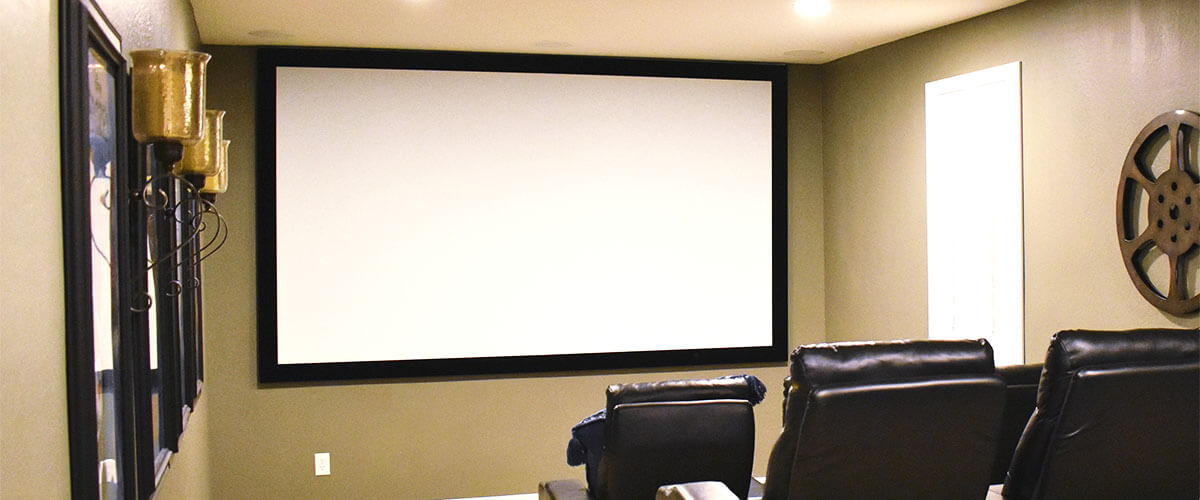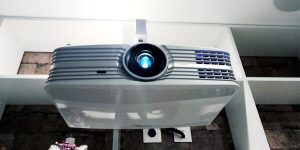If you’re in the market for a new home theater setup, you’ve probably realized that choosing the right types of projector screen can be a bit overwhelming. Every aspect plays a role in your viewing experience, from screen design and size to material choices. That’s why I’ve put together this comprehensive guide.
We’ll investigate how screen design, size, material, viewing distance, and aspect ratio are paramount for top-notch picture quality. My aim? To help you understand these key factors and find the perfect types of screen for your unique needs. Let’s get started!
Screen construction types

Fixed frame screens
Let me tell you that when it comes to choosing a projector screen for a home, fixed frame screens are a really good option. Their sturdy construction means they stay put, providing a reliable and stable foundation for your projection areas. Their dense, smooth surface is key to a consistently flat viewing area, which is super important for getting the perfect picture quality. These screens are particularly great for dedicated home theater applications, as they can accommodate various screen materials. You set it up once and are good to go for endless movie nights!
Retractable screens
Retractable screens are your go-to if you’re short on space or prefer a cleaner look when not watching movies. You’ve got two types here: manual and motorized. Personally, I love the convenience of a motorized screen – with just a click of a button, it disappears into its housing. Manual ones are more hands-on but equally effective. The main thing to consider is tension. It is important that the screen remains flat and smooth when extended. Otherwise, you might end up with those annoying creases or waves that can really mess with your image quality.
Portable and inflatable screens
For those who love outdoor movie nights or need a screen for different locations, an inflatable and portable projector screen is a lifesaver. They are incredibly easy to set up and transport, making them optimal for outdoor events, presentations, or even impromptu movie sessions in the backyard. The trade-off, though, comes in terms of image quality and stability. They might not be as robust or offer the same picture quality as fixed or retractable screens, but the versatility of a portable projector screen is hard to beat when you’re on the move.
Size

It’s time to get the size right for your big projector screen. First thing, measure your room. Trust me, it’s key to know how much space you’re working with. The greatest way is to figure out the maximum and minimum projector screen dimensions that’ll fit comfortably. Remember, it’s not just about fitting the screen; consider the room layout and your projector’s capabilities.
Now, about resolution – it’s super important. You need a screen that matches your projector’s native resolution to avoid any pixelation. I’ve learned that bigger isn’t always better. A huge screen can be overkill in smaller rooms, causing viewer fatigue. So, balance is important. Personal preference plays a big part, too, so go with what feels right for you and your space.
Materials

You’ve probably heard of matte white screens, right? These are classic, offering a clean, crisp image in a dimly lit room. But if you have a bit of ambient light to contend with high-contrast gray screens are your friend. They’re great at maintaining deeper blacks and enhancing contrast.
Now, onto something called ‘gain.’ This is all about how much light your screen reflects back. Higher gain means brighter images, but watch out – it can narrow your viewing angle.
Durability-wise, these materials are pretty solid but need some TLC. Keep them clean and away from direct sunlight to avoid fading. I’ve seen screens last ages with the right care, but remember, things like humidity and smoke can shorten their lifespan.
Viewing distance

THX and SMPTE are like the gold standard in the industry. They recommend that your viewing distance should be about 1.5 to 2.5 times the diagonal size of your screen, especially if you’re rocking a high-resolution projector.
Have you ever noticed how the picture quality drops when you’re not sitting dead-center? That’s the viewing cone for you. The further you move off-axis, the more the image can fade or color shift.
In my home theater, I’ve often played around with seating arrangements. My tip is to angle your seats in a slight arc, facing the screen. This setup helps ensure everyone gets a decent view without craning their necks. Remember, the sweet spot is front and center, but with a good screen and setup, every seat can be the greatest seat in the house.
Aspect ratio

The most common ratios are 16:9 and 4:3. If you’re like me, binge-watching movies or gaming, a 16:9 screen is your go-to – it’s perfect for most modern content. But if you’re into classic films or use your projector for presentations, a 4:3 screen might be better.
In a room where you’re mixing it up – movies, TV shows, gaming, you name it – an adjustable format screen is a game-changer. These screens can switch between ratios, so you always get the ideal view. From personal experience, having that flexibility is a lifesaver in a multi-purpose space. You’ll thank yourself for going with a versatile screen that adapts to whatever you’re watching.
Choosing the right projection screen

- Room ambiance: Assess your room’s lighting and choose a screen design accordingly.
- Size it right: Measure your space and pick a screen that fits comfortably.
- Material matters: Consider your room’s conditions and choose a material that enhances picture quality.
- Viewing distance: Calculate the ideal distance based on your screen size.
- Aspect ratio: Decide based on your primary viewing content – movies, general TV, or gaming.
It’s all about what works well for you and your space. Happy screening!
FAQ
Can I use a white wall instead of a projection screen?
In a nutshell, you can, but it’s not the optimal solution. While it’s a budget-friendly option, the image quality doesn’t compare. Projector screens are designed to enhance picture clarity and color. A white wall often lacks the reflective properties necessary for a crisp image.
What is screen gain, and how does it affect my viewing experience?
It refers to how much light a screen reflects back towards the viewer. A higher gain means brighter images, which is great in some settings. But be cautious – too high a gain can lead to hotspots and limited viewing angles.
Can ambient light-rejecting screens really make a difference in a bright room?
Absolutely! I used to struggle with glare in my sunlit living room. An ambient light-rejecting screen was a revolutionizer. These screens are designed to minimize the impact of natural and artificial light, ensuring better picture quality even in bright conditions. It’s like night and day compared to standard screens.
How does the screen’s frame affect the viewing experience?
A solid frame keeps the screen properly tensioned, avoiding wrinkles and waves that can distort the image. Some frames are also covered in black velvet, which helps absorb excess light, enhancing the perceived contrast of the image.
Do I need a special screen for 3D, 4K, or HDR content?
Higher-resolution content like 4K or HDR benefits from screens with finer textures, ensuring that the extra detail is accurately represented. As for 3D, while most screens work, some are better at preserving brightness and reducing cross-talk. So yes, considering your content type when choosing a screen is a smart move.









